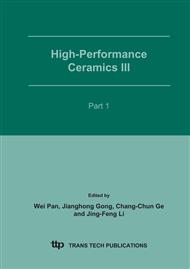p.1515
p.1519
p.1525
p.1529
p.1533
p.1537
p.1541
p.1545
p.1549
Morphology Tailoring of Hydroxyapatite Nanoparticles by Hydrothermal Processing with Amino Acids
Abstract:
Hydroxyapatite (HAp) was synthesized in the presence of a variety of amino acids in order to investigate the effect of amino acid on the morphology of HAp obtained by homogeneous precipitation and hydrothermal treating. In the results of X-ray diffraction analysis, HAp synthesized in the presence of some amino acids showed different crystallinity compared with HAp synthesized in the absence of amino acid. The results of Fourier transform infrared spectroscopy suggested the adsorption of these amino acids on HAp. Microphotographs of transmission electron microscope showed that the size and morphology of HAp adsorbed amino acids changed significantly. Collectively, this study suggests that the morphology and the crystallinity of synthesized HAp are different owing to the variation of amino acids in the synthesizing condition.
Info:
Periodical:
Pages:
1533-1536
Citation:
Online since:
February 2007
Authors:
Keywords:
Price:
Сopyright:
© 2005 Trans Tech Publications Ltd. All Rights Reserved
Share:
Citation:


